A Realistic and Integrated Model for Evaluating Offshore Oil Development
Abstract
:1. Introduction
1.1. Background
1.2. Related Works
1.3. Contributions
2. Offshore Oil Project Description
2.1. Offshore Oil Project Procedure
2.2. Offshore Oil Production Process
2.3. Offshore Oil Project Investment
3. Methodology
3.1. Regression Analysis
3.2. Integrated Economic Evaluation Models
3.2.1. Geological Reserve Estimation Model
3.2.2. Drilling and Completion Model
3.2.3. Underwater Production System Model
3.2.4. Platform Substructure Model
3.2.5. Platform Upper Chunk Model
3.2.6. Operation Cost Model
3.2.7. NPV Model
4. Case Studies
4.1. Basic Data
4.2. Results and Discussion
4.2.1. Economic Benefit Analysis
4.2.2. Sensitivity Analysis of All Parameters
4.2.3. Sensitivity Analysis of Oil Price
4.2.4. Sensitivity Analysis of Parameters under Low Oil Price
4.2.5. Influence of Parameter Uncertainty under Different Oil Prices
5. Conclusions
Author Contributions
Funding
Informed Consent Statement
Data Availability Statement
Acknowledgments
Conflicts of Interest
Appendix A. Regression Analysis
References
- Watson, S.M. Greenhouse gas emissions from offshore oil and gas activities—Relevance of the Paris Agreement, Law of the Sea, and Regional Seas Programmes. Ocean Coast. Manag. 2020, 185, 104942. [Google Scholar] [CrossRef]
- Rui, Z.; Li, C.; Peng, F.; Ling, K.; Chen, G.; Zhou, X.; Chang, H. Development of industry performance metrics for offshore oil and gas project. J. Nat. Gas Sci. Eng. 2017, 39, 44–53. [Google Scholar] [CrossRef]
- EIA. Oil and Petroleum Products Explained Offshore Oil and Gas; EIA: Washington, DC, USA, 2021. Available online: https://www.eia.gov/energyexplained/oil-and-petroleum-products/offshore-oil-and-gas-in-depth.php. (accessed on 9 March 2021).
- IEA. Offshore Energy Outlook; IEA: Paris, France, 2018; Available online: https://www.iea.org/reports/offshore-energy-outlook-2018. (accessed on 9 March 2021).
- Khan, F.; Ahmed, S.; Yang, M.; Hashemi, S.J.; Caines, S.; Rathnayaka, S.; Oldford, D. Safety challenges in harsh environments: Lessons learned. Process Safty Prog. 2014, 34, 191–195. [Google Scholar] [CrossRef]
- Rahman, M.S.; Khan, F.; Shaikh, A.; Ahmed, S.; Imtiaz, S. Development of risk model for marine logistics support to offshore oil and gas operations in remote and harsh environments. Ocean Eng. 2019, 174, 125–134. [Google Scholar] [CrossRef]
- Vidal, P.C.J.; González, M.O.A.; Vasconcelos, R.M.; Melo, D.C.; Ferreira, P.O.; Sampaio, P.G.V.; Silva, D.R. Decommissioning of offshore oil and gas platforms: A systematic literature review of factors involved in the process. Ocean Eng. 2022, 255, 111428. [Google Scholar] [CrossRef]
- Shi, X.; Variam, H.M.P. East Asia’s Gas-Market Failure and Distinctive Economics—A Case Study of Low Oil Prices. Appl. Energy 2017, 195, 800–809. [Google Scholar] [CrossRef]
- Wang, Y.; Estefen, S.F.; Lourenço, M.I.; Hong, C. Optimal Design and Scheduling for Offshore Oil-Field Development. Comput. Chem. Eng. 2019, 123, 300–316. [Google Scholar] [CrossRef]
- de Lucena, R.R.; Baioco, J.S.; de Lima, B.S.L.P.; Albrecht, C.H.; Jacob, B.P. Optimal Design of Submarine Pipeline Routes by Genetic Algorithm with Different Constraint Handling Techniques. Adv. Eng. Softw. 2014, 76, 110–124. [Google Scholar] [CrossRef]
- Rosa, V.R.; Camponogara, E.; Filho, V.J.M.F. Design Optimization of Oilfield Subsea Infrastructures with Manifold Placement and Pipeline Layout. Comput. Chem. Eng. 2018, 108, 163–178. [Google Scholar] [CrossRef]
- Hong, B.; Li, X.; Di, G.; Li, Y.; Liu, X.; Chen, S.; Gong, J. An Integrated MILP Method for Gathering Pipeline Networks Considering Hydraulic Characteristics. Chem. Eng. Res. Des. 2019, 152, 320–335. [Google Scholar] [CrossRef]
- Silva, L.M.R.; Soares, C.G. An Integrated Optimization of the Floating and Subsea Layouts. Ocean Eng. 2019, 191, 106557. [Google Scholar] [CrossRef]
- Wang, B.; Liang, Y.; Yuan, M.; Wang, J.; Zhang, H.; Li, X. Optimal Design of Oilfield Surface Pipeline Networks for the Cyclic Water Injection Development Method. J. Pet. Sci. Eng. 2018, 171, 1400–1408. [Google Scholar] [CrossRef]
- Gao, X.; Xie, Y.; Wang, S.; Wu, M.; Wang, Y.; Tan, C.; Zuo, X.; Chen, T. Offshore Oil Production Planning Optimization: An MINLP Model Considering Well Operation and Flow Assurance. Comput. Chem. Eng. 2020, 133, 106674. [Google Scholar] [CrossRef]
- Allahyarzadeh-Bidgoli, A.; Salviano, L.O.; Dezan, D.J.; de Oliveira Junior, S.; Yanagihara, J.I. Energy Optimization of an FPSO Operating in the Brazilian Pre-Salt Region. Energy 2018, 164, 390–399. [Google Scholar] [CrossRef]
- Veloso, T.G.C.; Sotomonte, C.A.R.; Coronado, C.J.R.; Nascimento, M.A.R. Multi-Objective Optimization and Exergetic Analysis of a Low-Grade Waste Heat Recovery ORC Application on a Brazilian FPSO. Energy Convers. Manag. 2018, 174, 537–551. [Google Scholar] [CrossRef]
- Reis, M.M.L.; Gallo, W.L.R. Study of Waste Heat Recovery Potential and Optimization of the Power Production by an Organic Rankine Cycle in an FPSO Unit. Energy Convers. Manag. 2018, 157, 409–422. [Google Scholar] [CrossRef]
- Kim, H.; Yoo, W.; Lim, Y.; Seo, Y. Economic Evaluation of MEG Injection and Regeneration Process for Oil FPSO. J. Pet. Sci. Eng. 2018, 164, 417–426. [Google Scholar] [CrossRef]
- de Andrade Cruz, M.; Araújo, O.D.Q.F.; de Medeiros, J.L. Deep Seawater Intake for Primary Cooling in Tropical Offshore Processing of Natural Gas with High Carbon Dioxide Content: Energy, Emissions and Economic Assessments. J. Nat. Gas Sci. Eng. 2018, 56, 193–211. [Google Scholar] [CrossRef]
- Wang, B.; Liang, Y.; Yuan, M. Water Transport System Optimisation in Oilfields: Environmental and Economic Benefits. J. Clean. Prod. 2019, 237, 117768. [Google Scholar] [CrossRef]
- Wang, B.; Liang, Y.; Zheng, T.; Yuan, M.; Zhang, H. Multi-Objective Site Selection Optimization of the Gas-Gathering Station Using NSGA-II. Process Saf. Environ. Prot. 2018, 119, 350–359. [Google Scholar] [CrossRef]
- Rui, Z.; Wang, X.; Zhang, Z.; Lu, J.; Chen, G.; Zhou, X.; Patil, S. A Realistic and Integrated Model for Evaluating Oil Sands Development with Steam Assisted Gravity Drainage Technology in Canada. Appl. Energy 2018, 213, 76–91. [Google Scholar] [CrossRef]
- Jeff, J. Steam Drive Model for Hand-Held Programmable Calculators. J. Pet. Technol. 1981, 33, 1583–1598. [Google Scholar]
- Sawhney, G.S.; Liebe, H.; Butler, R.M. Vertical Injection Wells For Sagd: A Practical Option Or Not? J. Can. Pet. Technol. 1995, 34, PETSOC-95-01-06. [Google Scholar] [CrossRef]
- Saini, D.; Jimenez, I.; Reedy, C.D.; Houghton, M. A Pseudo-SAGD Scoping Model for Evaluating Economic Viability of Heavy Oil Projects. J. Pet. Sci. Eng. 2016, 137, 125–133. [Google Scholar] [CrossRef]
- Wei, N.; Li, X.; Dahowski, R.T.; Davidson, C.L.; Liu, S.; Zha, Y. Economic Evaluation on CO2-EOR of Onshore Oil Fields in China. Int. J. Greenh. Gas Control 2015, 37, 170–181. [Google Scholar] [CrossRef]
- Jiang, J.; Rui, Z.; Hazlett, R.; Lu, J. An Integrated Technical-Economic Model for Evaluating CO2 Enhanced Oil Recovery Development. Appl. Energy 2019, 247, 190–211. [Google Scholar] [CrossRef]
- Mejean, A.; Hope, C. Modeling the costs of non-conventional oil: A case study of Canadian bitumen. Energy Policy 2008, 36, 4205–4216. [Google Scholar] [CrossRef]
- Giacchetta, G.; Leporini, M.; Marchetti, B. Economic and environmental analysis of a steam assisted gravity drainage (SAGD) facility for oil recovery from Canadian oil sands. Appl. Energy 2015, 142, 1–9. [Google Scholar] [CrossRef]
- National Bureau of Statistics of China, National Bureau of Statistics of China. Available online: http://data.stats.gov.cn/ (accessed on 3 February 2021).
- Chang, Y.; Wu, X.; Chen, G.; Ye, J.; Chen, B.; Xu, L.; Zhou, J.; Yin, Z.; Ren, K. Comprehensive risk assessment of deepwater drilling riser using fuzzy Petri net model. Process Saf. Environ. Prot. 2018, 117, 483–497. [Google Scholar] [CrossRef]
- Liu, M.; Wu, W.; Tang, D.; Ma, H.; Naess, A. Current profile analysis and extreme value prediction in the LH11-1 oil field of the South China Sea based on prototype monitoring. Ocean Eng. 2018, 153, 60–70. [Google Scholar] [CrossRef]
- Huang, W.; Gao, D. Analysis of drilling difficulty of extended-reach wells based on drilling limit theory. Pet. Sci. 2022, 19, 1099–1109. [Google Scholar] [CrossRef]
- Guedes, J.; Santos, P. Valuing an Offshore Oil Exploration and Production Project through Real Options Analysis. Energy Econ. 2016, 60, 377–386. [Google Scholar] [CrossRef]
- Wang, B.; Liang, Y.; Zheng, J.; Lei, T.; Yuan, M.; Zhang, H. A Methodology to Restructure a Pipeline System for an Oilfield in the Mid to Late Stages of Development. Comput. Chem. Eng. 2018, 115, 133–140. [Google Scholar] [CrossRef]
- Hamzah, B.A. International Rules on Decommissioning of Offshore Installations: Some Observations. Mar. Policy 2003, 27, 339–348. [Google Scholar] [CrossRef]
- Chandler, J.; White, D.; Techera, E.J.; Gourvenec, S.; Draper, S. Engineering and Legal Considerations for Decommissioning of Offshore Oil and Gas Infrastructure in Australia. Ocean Eng. 2017, 131, 338–347. [Google Scholar] [CrossRef]
- Caldwell, R.H.; Heather, D.I. How to evaluate hard to evaluate reserves. J. Pet. Technol. 1991, 43, 998–1000. [Google Scholar] [CrossRef]
- Di Leo, S.; Caramuta, P.; Curci, P.; Cosmi, C. Regression Analysis for Energy Demand Projection: An Application to TIMES-Basilicata and TIMES-Italy Energy Models. Energy 2020, 196, 117058. [Google Scholar] [CrossRef]

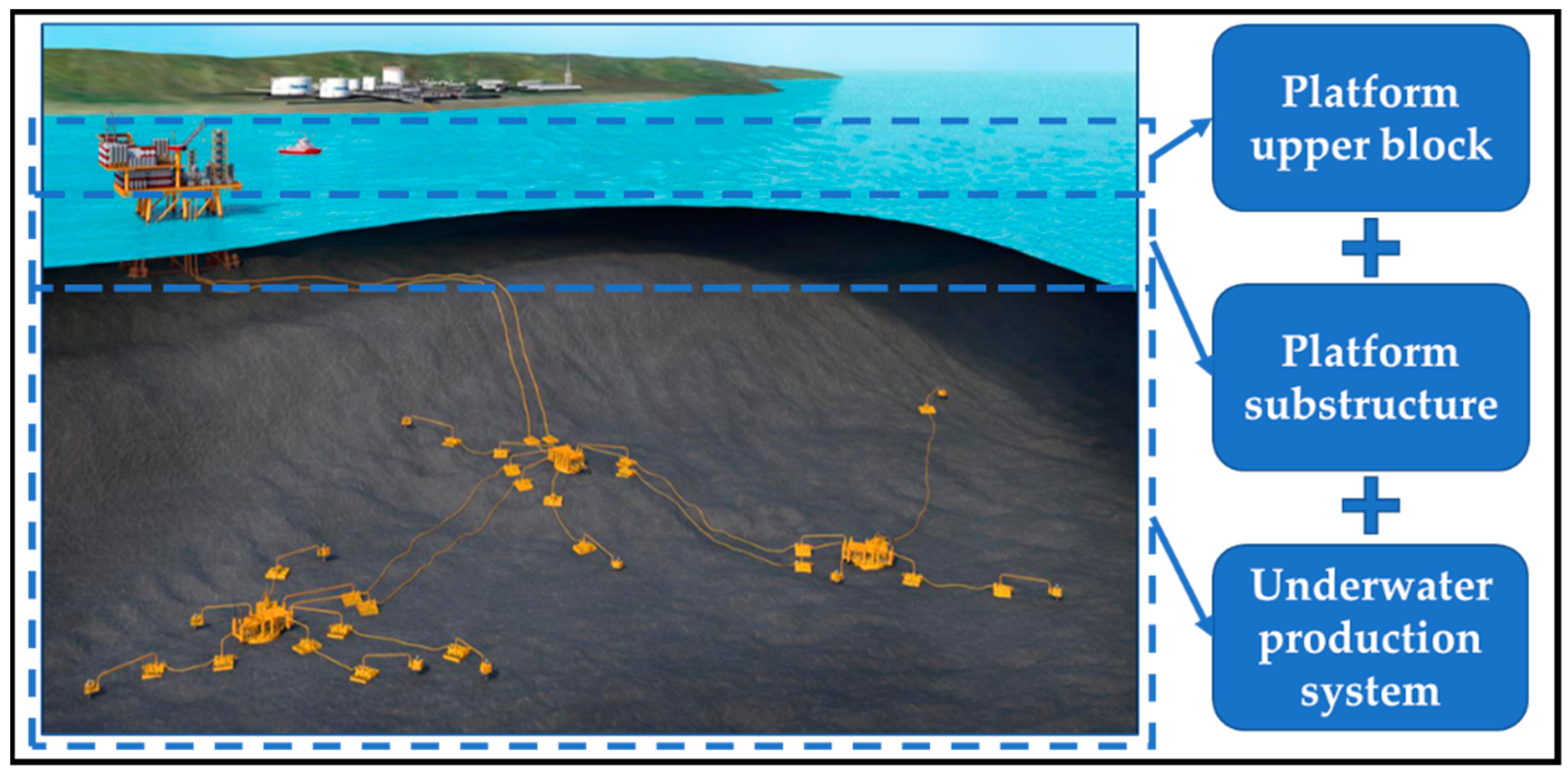
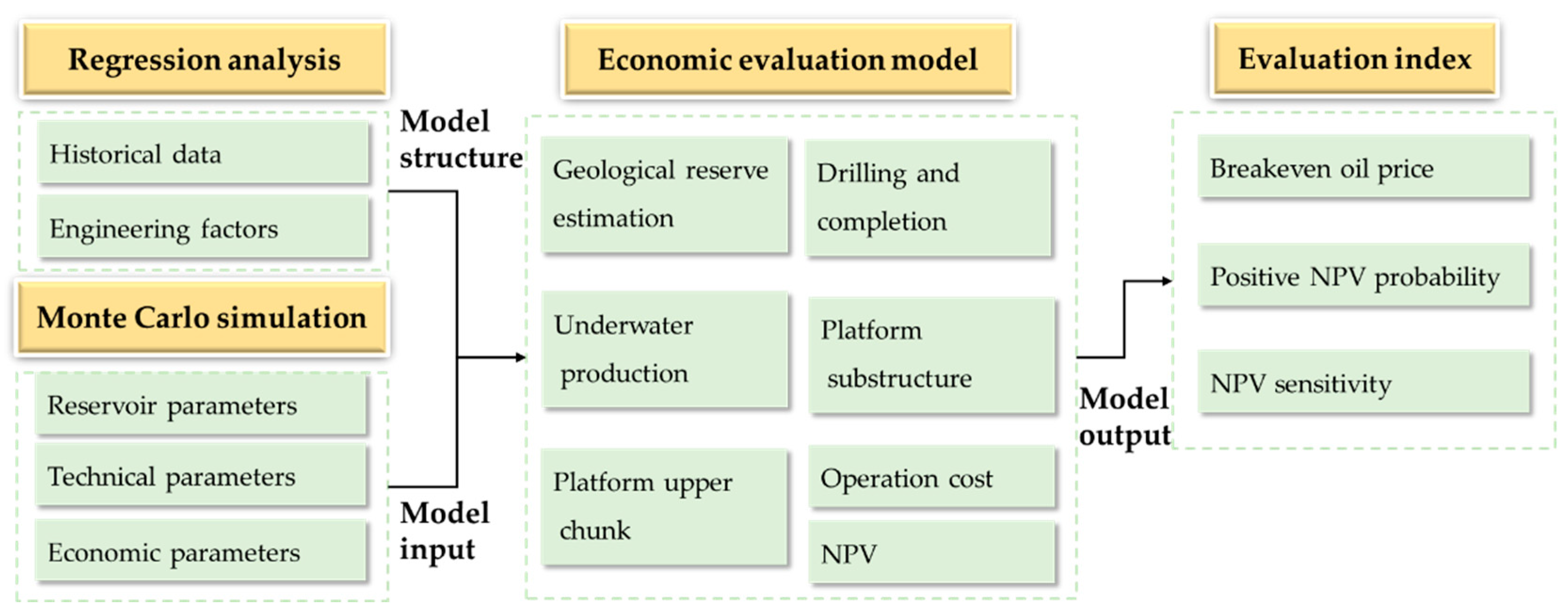
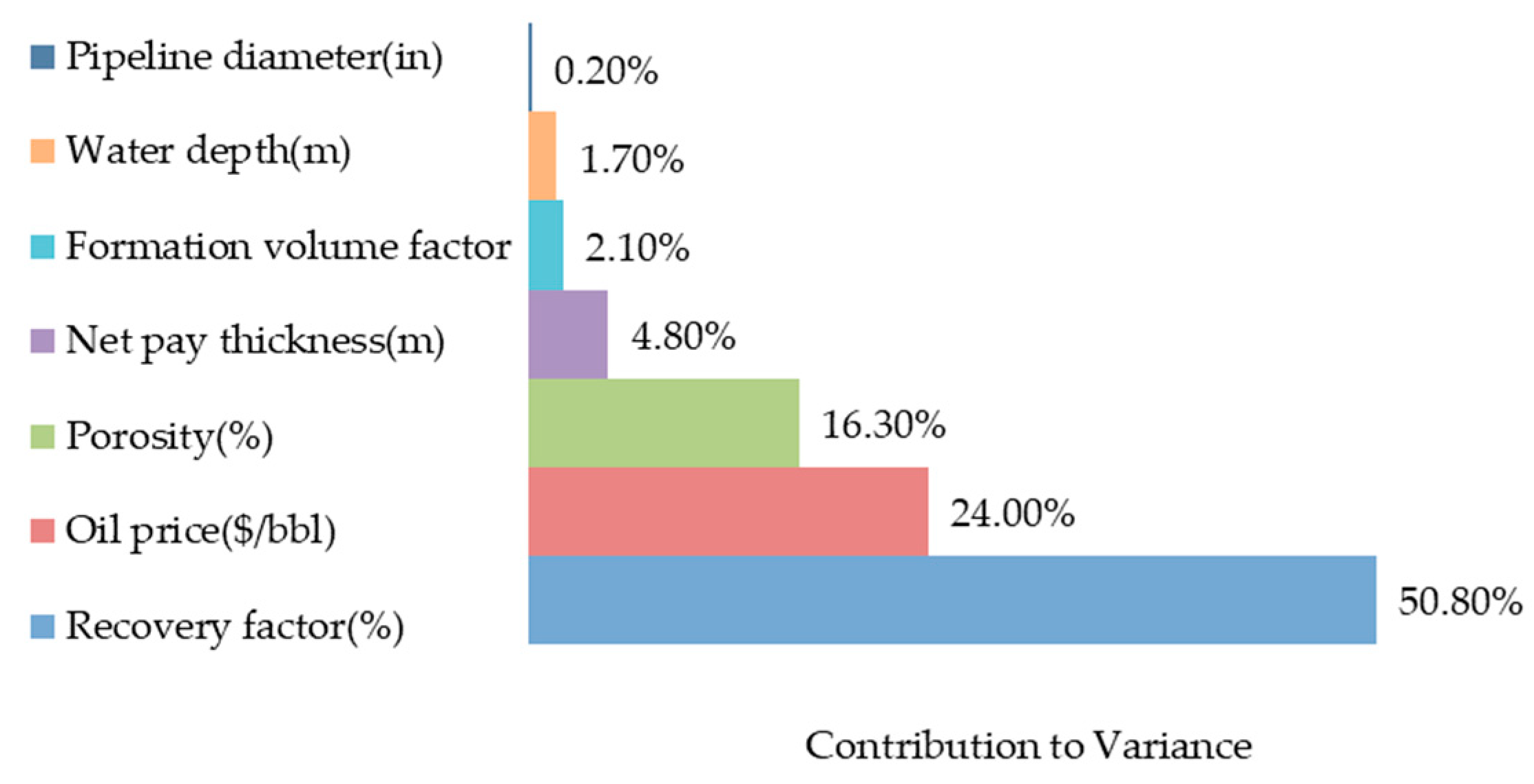
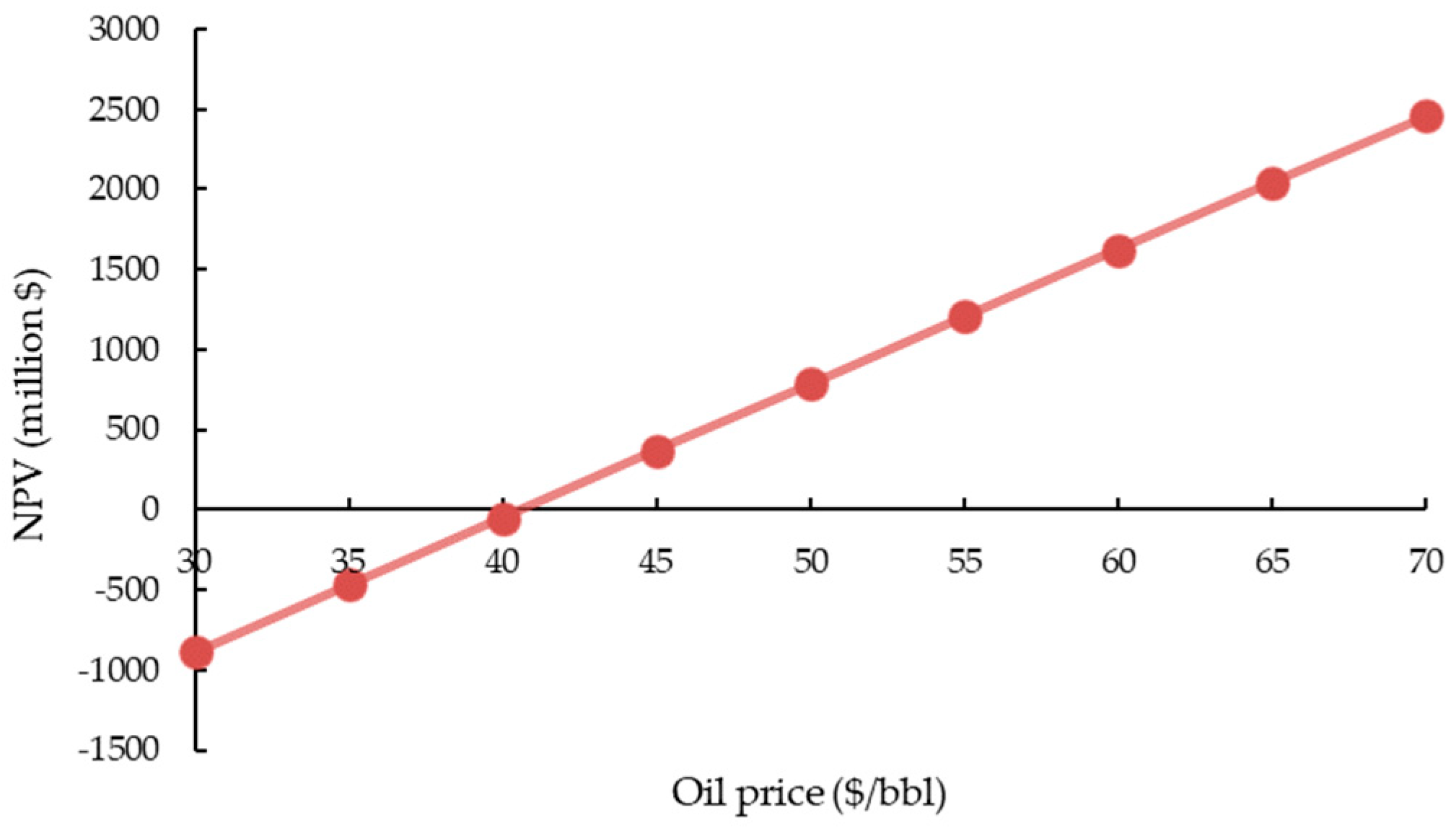
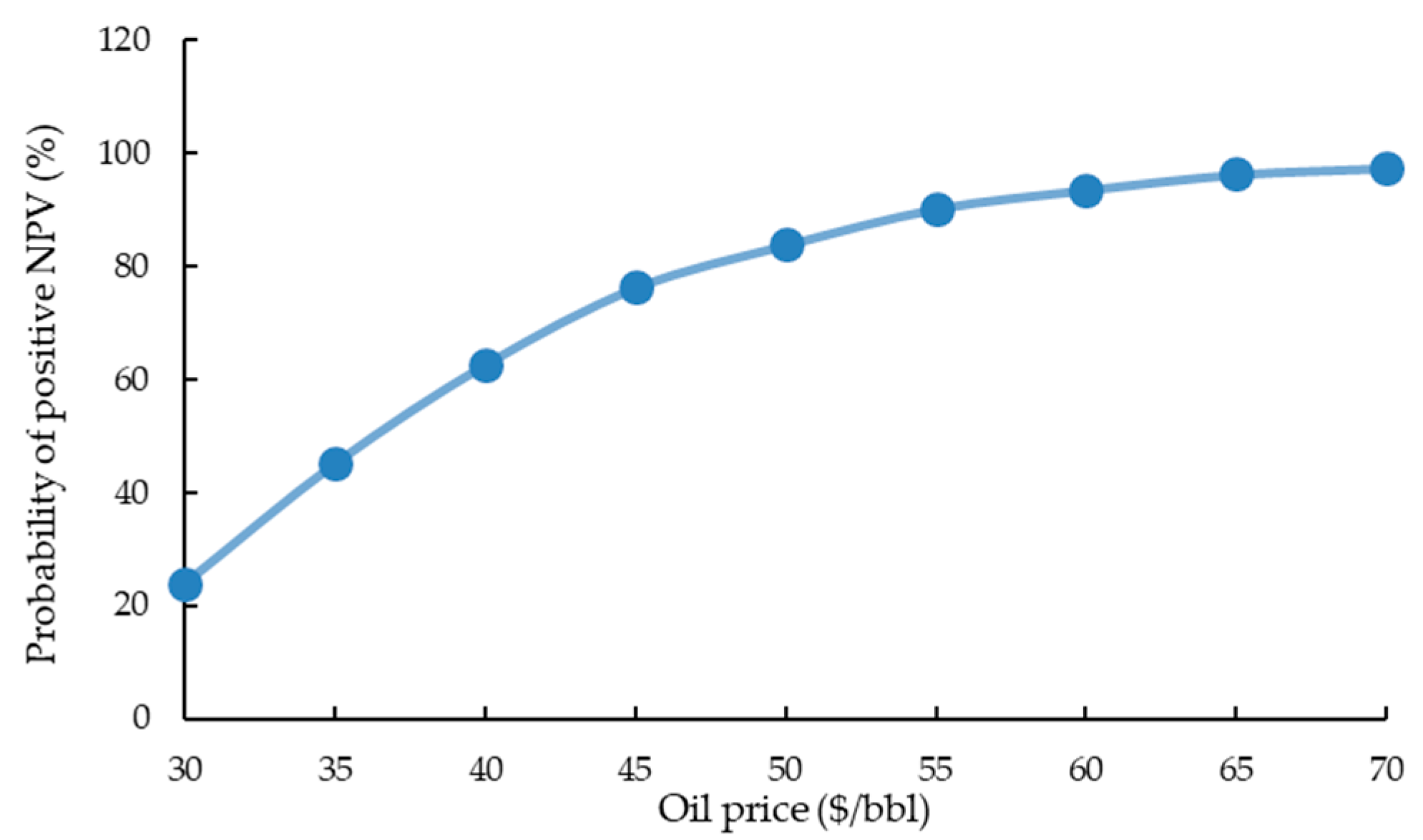
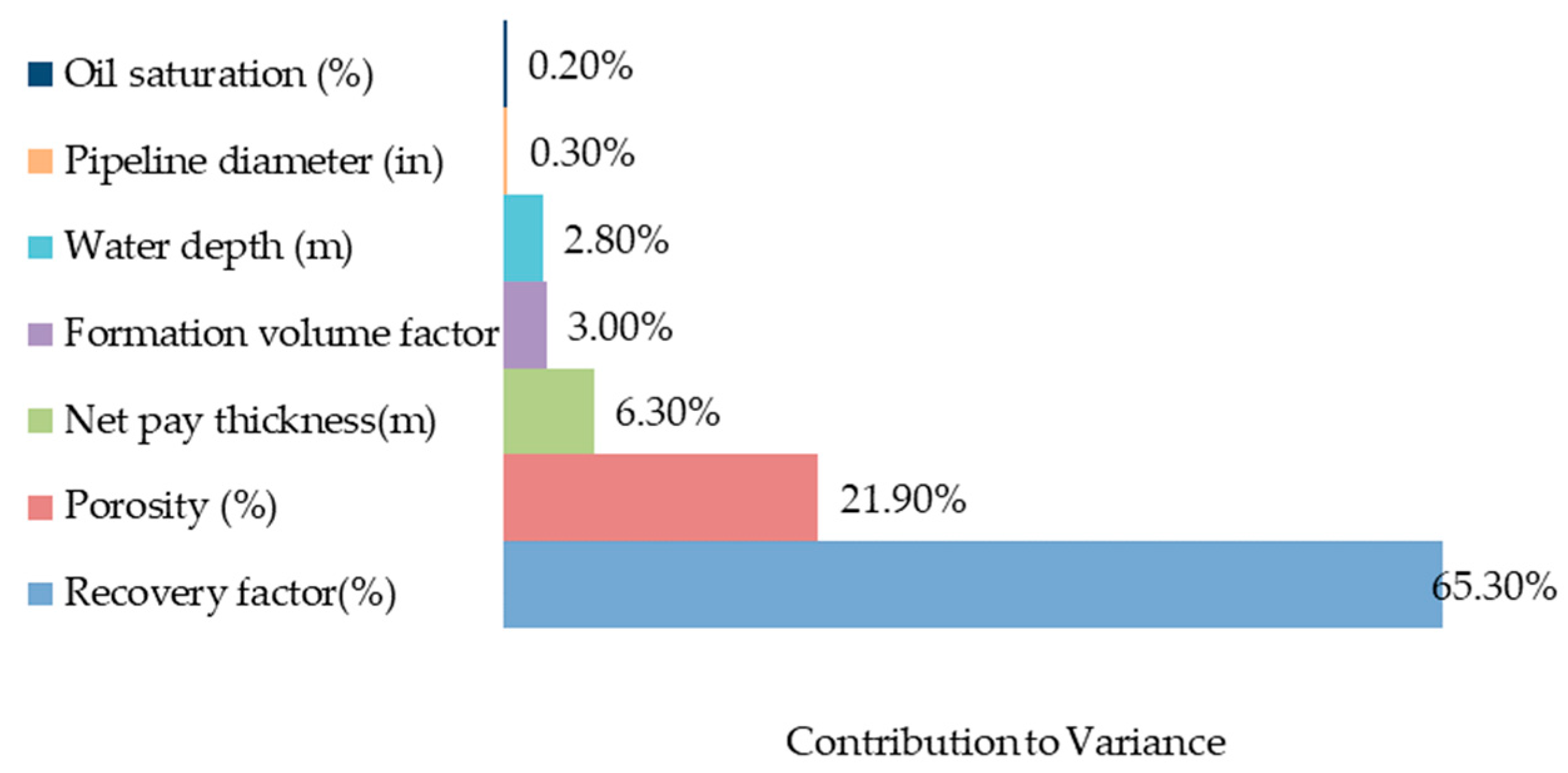
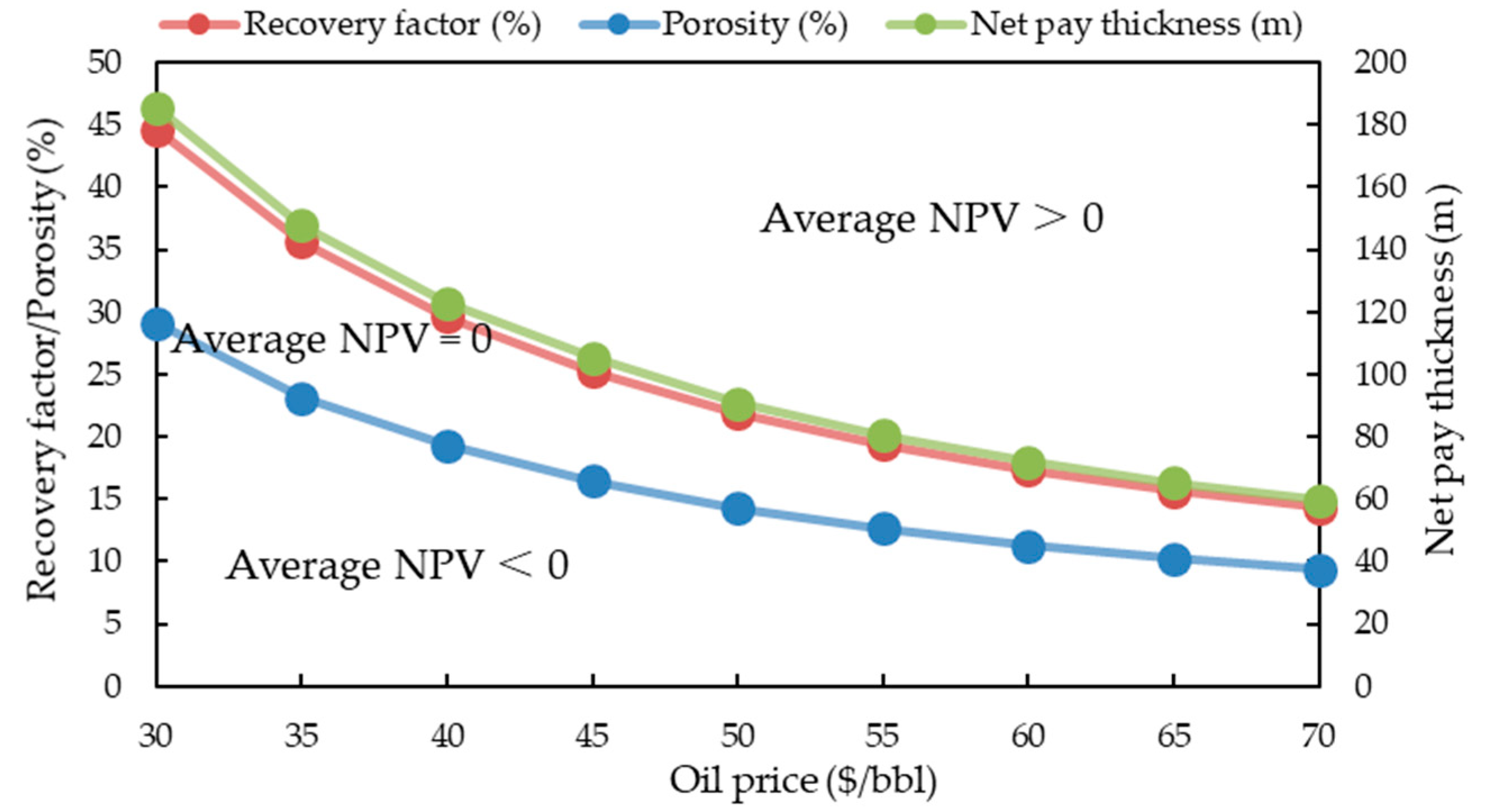
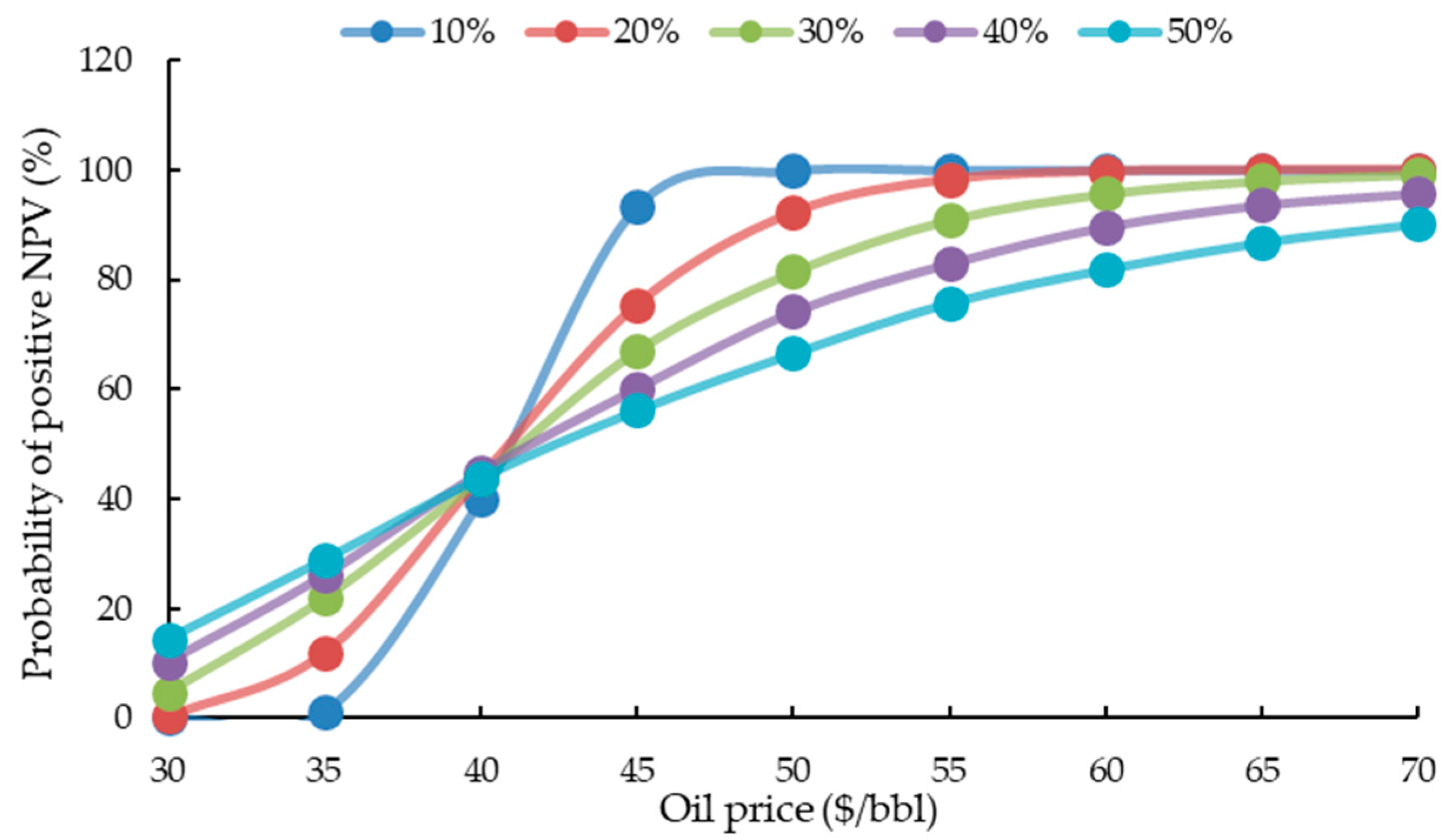
| Parameters | Average | Minimum | Maximum |
|---|---|---|---|
| Drilling and completion cost (million USD) | 10.00 | 3.71 | 8.85 |
| Well depth (m) | 2223 | 1400 | 3100 |
| Water depth (m) | 60.83 | 16.00 | 116.00 |
| Drilling cycle (day) | 30.35 | 16.10 | 75.00 |
| Parameters | Base | Minimum | Maximum |
|---|---|---|---|
| Drainage area (km2) | 10 | 10 | 10 |
| Net pay thickness (m) | 149.4 | 110.9 | 187.9 |
| Water depth (m) | 1200 | 50 | 2000 |
| Porosity (%) | 21 | 14 | 35 |
| Oil saturation (%) | 71.37 | 69.27 | 73.46 |
| Formation volume factor | 1.23 | 1.04 | 1.23 |
| Recovery factor (%) | 33 | 11 | 64 |
| Well depth (m) | 3415 | 3100 | 3491 |
| Gas and oil ratio (m3/m3) | 87.60 | 35.74 | 66.33 |
| Drilling cycle (day) | 44 | 15 | 78 |
| Pipeline length (km) | 20 | 5.39 | 25 |
| Pipeline diameter (in) | 10 | 4 | 18 |
| Pipeline wall thickness (in) | 0.43 | 0.43 | 0.68 |
| Oil price (USD/bbl) | 45 | 30 | 70 |
| Royalty rate (%) | 10 | 10 | 10 |
| Discounted rate (%) | 10 | 10 | 10 |
| Income tax rate (%) | 11 | 11 | 11 |
| Outcome (Million USD) | Base | Average | Low | High |
|---|---|---|---|---|
| Drilling and completion cost | 774.96 | 726.60 | 221.05 | 1210.59 |
| Underwater production system cost | 1145.84 | 1153.83 | 999.23 | 1299.18 |
| Platform substructure cost | 481.94 | 514.59 | 250.33 | 1055.76 |
| Platform upper chunk cost | 663.88 | 681.54 | 588.79 | 906.92 |
| Total investment | 3066.62 | 3077.96 | 2173.56 | 4077.04 |
| Operation cost | 2883.17 | 3261.14 | 742.34 | 6521.98 |
| Revenue | 14,732.39 | 17,766.71 | 3495.91 | 51,365.27 |
| Operation profit | 6426.63 | 8539.93 | −541.53 | 34,735.32 |
| Income tax | 882.74 | 1150.47 | −4.02 | 3844.56 |
| Royalty fee | 1473.24 | 1771.49 | 361.83 | 5447.36 |
| NPV | 369.09 | 1029.21 | −1880.67 | 7839.33 |
Publisher’s Note: MDPI stays neutral with regard to jurisdictional claims in published maps and institutional affiliations. |
© 2022 by the authors. Licensee MDPI, Basel, Switzerland. This article is an open access article distributed under the terms and conditions of the Creative Commons Attribution (CC BY) license (https://creativecommons.org/licenses/by/4.0/).
Share and Cite
Qiu, R.; Li, Z.; Zhang, Q.; Yao, X.; Xie, S.; Liao, Q.; Wang, B. A Realistic and Integrated Model for Evaluating Offshore Oil Development. J. Mar. Sci. Eng. 2022, 10, 1155. https://doi.org/10.3390/jmse10081155
Qiu R, Li Z, Zhang Q, Yao X, Xie S, Liao Q, Wang B. A Realistic and Integrated Model for Evaluating Offshore Oil Development. Journal of Marine Science and Engineering. 2022; 10(8):1155. https://doi.org/10.3390/jmse10081155
Chicago/Turabian StyleQiu, Rui, Zhuochao Li, Qin Zhang, Xin Yao, Shuyi Xie, Qi Liao, and Bohong Wang. 2022. "A Realistic and Integrated Model for Evaluating Offshore Oil Development" Journal of Marine Science and Engineering 10, no. 8: 1155. https://doi.org/10.3390/jmse10081155
APA StyleQiu, R., Li, Z., Zhang, Q., Yao, X., Xie, S., Liao, Q., & Wang, B. (2022). A Realistic and Integrated Model for Evaluating Offshore Oil Development. Journal of Marine Science and Engineering, 10(8), 1155. https://doi.org/10.3390/jmse10081155









